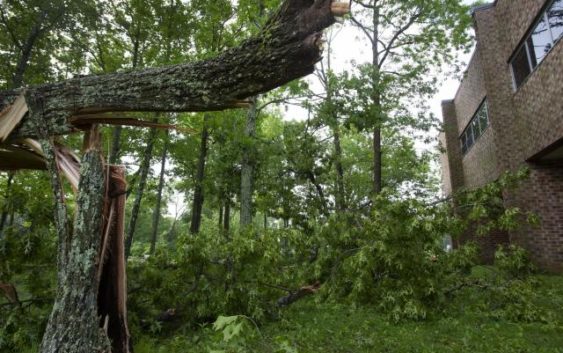- The Texanist: Texas Gets More Tornadoes Than Any Other State, but Don’t Freak Out
- U.S. Supreme Court says Texans can sue state for flood damage
- This is how many hurricanes NC State researchers predict this year
- NC State researchers predict above-average hurricane season
- Supreme Court rules in favor of property owners suing Texas over flood damage
Tornado warning? In East, storm season brings bewilderment

NEWARK, N.J. — As a tornado bore down on the western edge of New Jersey, some residents prepared for the worst, while others were caught off guard, despite bulletins from meteorologists and extensive coverage by television and radio stations.
Marie Raffay was at a high school sports award banquet in Stanhope on Tuesday night with her husband and two sons when they and others noticed the sky darkening, accompanied by thunder and lightning.
“We figured it was a typical late afternoon storm,” Raffay said. “Then the windows got pushed in by the pressure. I said to another woman, ‘I don’t think we should be standing there.'”
One person in the group mentioned getting a tornado warning on his phone, said Raffay, a civil engineer, but others were unaware.
The nation has seen a surge in tornadoes this month, with Tuesday setting a record as the 12th consecutive day with at least eight reported. Some tornado warnings have edged into areas of the East Coast unaccustomed to such storms, where many people are not conditioned to hear or heed such alerts.
New Jersey gets a handful of tornadoes per year on average. Two twisters hit New York City on one day in 2012, but only about 60 had hit the area in the 50 years before that, according to the National Weather Service.
“The fact is that in New Jersey, tornadoes are too rare for there to be a well-designed warning system in most communities, nor a properly educated public who know what to do when a warning is issued,” said David Robinson, the state’s climatologist and a professor at Rutgers University.
Tuesday’s tornado damaged Lenape Valley Regional High School’s facade and ripped up a softball dugout, depositing the roof on its side on the ground. Toppled trees and power lines left most residents without electricity.
In Ohio, where tornadoes are far more common, meteorologists went on the offensive Monday night with aggressive tornado warnings, actions several officials said saved lives.
“Pretty miraculous” is how Dayton Fire Chief Jeffrey Payne described the survival statistics on Tuesday morning.
“I attribute much of that to the early notification to the public, and then the public heeding those warnings and getting shelter,” Payne said. At the time, no fatalities had been reported. Later, authorities said a single man was killed in Celina when winds pushed a car into his house.
Not everyone was pleased with the information dump. Some television viewers, apparently inured to weather alerts, complained on social media about an Ohio meteorologist interrupting “The Bachelorette” with a tornado warning, leading him to deliver an on-air scolding .
“No, we’re not going back to the show, folks,” Dayton meteorologist Jamie Simpson said. “This is a dangerous situation, OK?”
Current Bachelorette Hannah Brown stood up for Simpson in a tweet , thanking supporters in Dayton for their love but urging them to be safe. “Naders are no joke,” the former Miss Alabama USA tweeted.
The nature of tornadoes puts a premium on preparation, according to longtime WCBS Radio meteorologist Craig Allen. Unlike hurricane warnings, which often are issued 24 to 48 hours ahead of time, a tornado watch often is issued six to eight hours in advance, and a warning isn’t given until a tornado is seen on radar.
Tornadoes in New Jersey and the surrounding area also can be more difficult to detect without the help of radar, Allen said.
“Tornadoes around here aren’t the same as elsewhere, where you can see them for miles and miles,” he said. “They are rain-wrapped, and they are small spinoffs; you usually don’t see them tracking across miles of land. If it wasn’t for radar, we wouldn’t even know some of them are there.”
Scott Olson, a resident of Byram, New Jersey, where Tuesday’s tornado caused damage, recalled growing up in Minnesota and being conditioned to swing into action when the tornado sirens would go off, even in the dead of night.
“We’d go downstairs, grab a pillow and blanket and go into the basement, and stay there until it passed,” Olson said.
On Tuesday night, Olson received an emergency weather alert through his cable provider. By that time, he said, the storm had already arrived.
___
Associated Press writers Kantele Franko and Andrew Welsh-Huggins in Columbus, Ohio, contributed to this report.